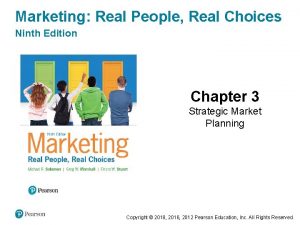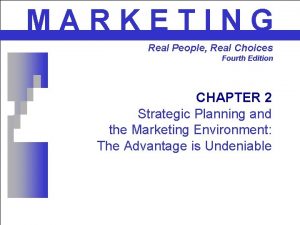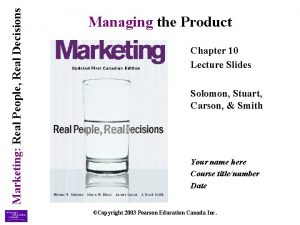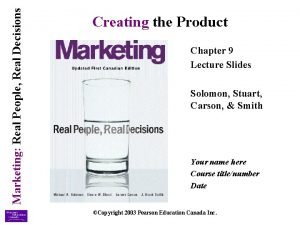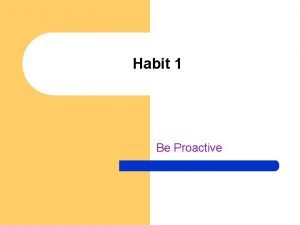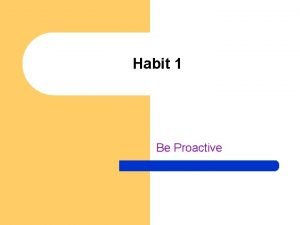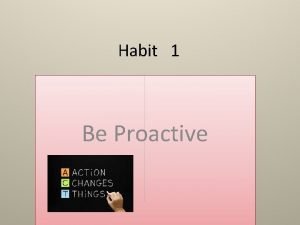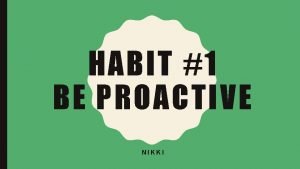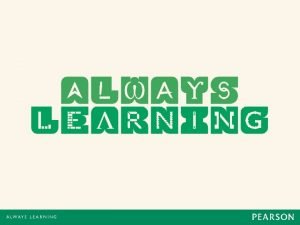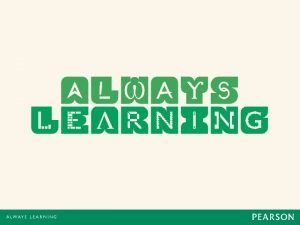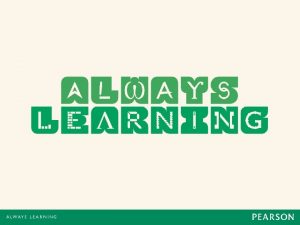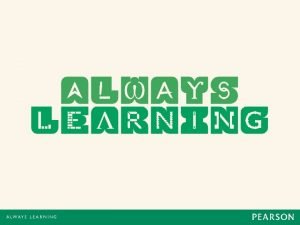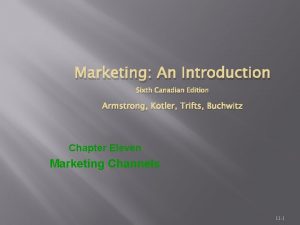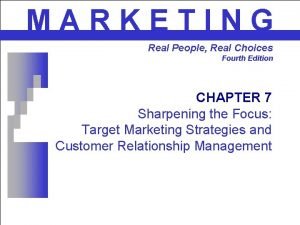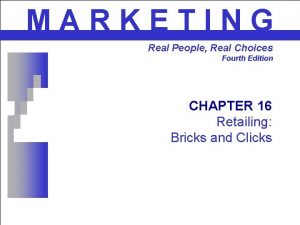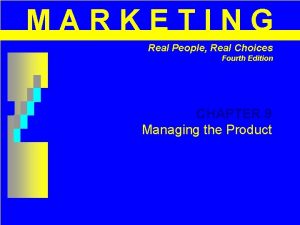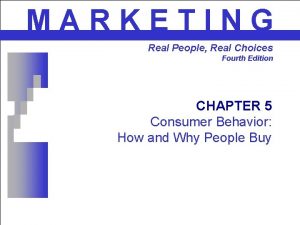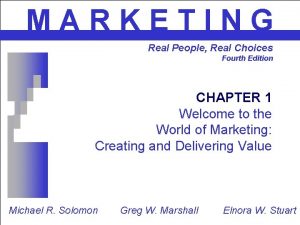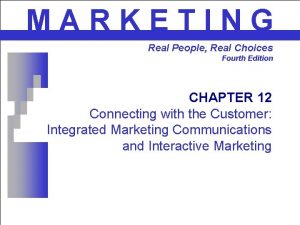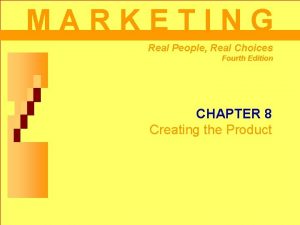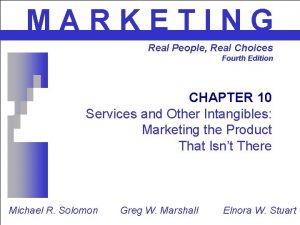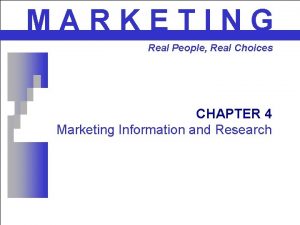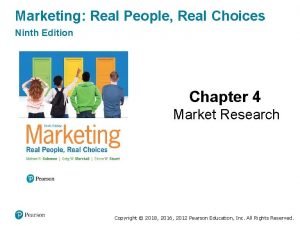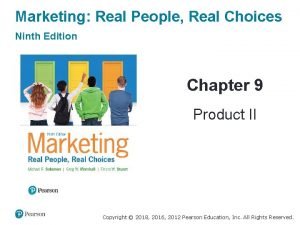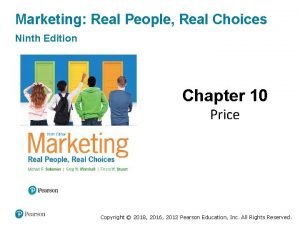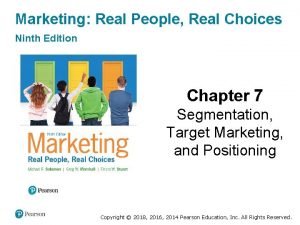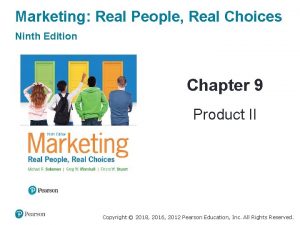MARKETING Real People Real Choices Fourth Edition CHAPTER

































- Slides: 33

MARKETING Real People, Real Choices Fourth Edition CHAPTER 4 Marketing Information and Research: Analyzing the Business Environment Off-line and Online

Knowledge is Power • A Marketing Information System (MIS) determines what information managers need and then gathers, sorts, analyzes, stores, and distributes relevant and timely marketing information to system users • What market info. do you need? – Should we change our ad campaign? – Should we change our packaging? 2

Four types of data • Internal Data – sales reports, old market research, complaint records, profit and loss statements, etc. – intranet • Marketing Intelligence - method to get information about the environment – newspapers, trade publications, www, observations in market place – Mystery shoppers 3

Four types of data • Marketing Research - process of collecting, analyzing, and interpreting data about customers, competitors, and the business environment to improve marketing effectiveness • Two types: – Syndicated research – Custom research 4

Four types of data • Syndicated research reports – secondary data collected and compiled by firms on a regular basis and sold to many firms. e. g. Nielsen’s TV ratings, Arbitron ratings, Simmons Market Research Bureau – CB, demographics and media usage) • Custom research reports – primary data collected to provide answers to specific questions 5

Four types of data • Acquired databases: many companies collect information about you and sell it to others at a cost • Opt out clauses • Spam and junkmail • Do-not-call lists 6

Marketing Decision Support Systems (MDSS) • MIS System + analysis (statistical and modeling software) + interactive capabilities • Allows managers to conduct their own analyses • Allows posing “what-if” scenarios • E. g. How do consumers perceive our brand w. r. t. competition? • E. g. Would withdrawing the ad campaign result in a decline in sales? 7

Differences in MIS and MDSS MIS • What were our company sales of each product during the last month and the last year? MDSS • Have our sales declines simply reflected changes in overall industry sales or is there some portion of the decline that cannot be explained by industry changes? 8

Differences in MIS and MDSS • MIS – What medium best reaches my target audience? – What were our sales this season and the same time last season? • MDSS – How much will my sales improve if I use radio instead of TV? – Was the improvement in our sales this season due to the new pricing plan? 9

Search for Gold: Data Mining • Data mining is a process in which analysts sift through data to identify unique patterns of behavior among different customer groups • 4 key applications for marketers: – customer acquisition (e. g. make offers based on matched key customer characteristics) – customer retention (isolate big-spenders and send them special offers other do not receive) – customer abandonment (Fedex and “the good, the bad and the ugly” – market basket analysis (Fingerhut and mailers for gas grilles based on purchases of outdoor patio furniture) 10

Marketing Research Process: Step 1 • Specify the research objectives • Identify the consumer population of interest • Place the problem in an environmental context – What factors may be influencing the situation 11

Step 2: Determine the Design • Can the information be acquired from existing data? – If so, secondary data sources will be utilized (e. g. if you want to know zip code-wise population clusters, you can get this data from the Census) – If not, primary research will be necessary 12

Exploratory Research • Generally provides qualitative data • May take several forms – Consumer interviews – Focus groups – Case studies – Ethnography – Projective techniques – explore underlying feelings in the face of unwillingness or inarticulation • E. g. – What thoughts come to your mind when you think of “Winthrop”? – What do you think about high gas prices? 13

Descriptive Research • Utilizes a large sample of participants as base • Generally provides quantitative data • Designs – Cross-sectional design involves the systematic collection of quantitative information from one or more samples of respondents at one point in time – Longitudinal design tracks the responses of the sample of respondents over time 14

Descriptive Research • Cross-sectional Designs: – Measuring consumer response to a new product in the market • Longitudinal Design: – Measuring consumer attitude to a brand every one month 15

Causal Research • Attempts to understand cause-andeffect relationships • Factors that might cause a change are independent variables while the variables that are affected are dependent variables • Experimental design allows researchers to control possible explanations for the effect 16

Causal Research • Example: – Measuring consumer response to a brand before and after seeing a new commercial • It is important to rule out other possible causes of the effect – E. g. Existing brand loyalties may influence the effect. This has be controlled. 17

Step 3: Choose the Data Collection Method • Communication – Mail questionnaires – Telephone interviews – Face-to-face interviews – Online questionnaires • Observation – Personal – Mechanical 18

Mail Questionnaires • Advantages – Respondents feel anonymous – Low cost – Good for ongoing research • Disadvantages – Slow return speed – Low response rates typical – Inflexible questionnaire – Length of survey is limited 19

Telephone Interviews • Advantages – Fast – Low cost – Limited interviewer bias • Disadvantages – Decreasing levels of cooperation – Limited questionnaire length – Consumers screen calls 20

Face-to-Face Interviews • Advantages – Flexibility of questioning – Long questionnaires possible – Can help explain questions – Can use visuals • Disadvantages – High cost – Interviewer bias possible – Time requirements are high 21

Online Questionnaires Advantages • Instant data collection • Low cost • No interviewer bias • Access regardless of geographic location Disadvantages • Unclear who is responding • No assurance of honesty • Limited questionnaire length • Limitations inherent with self-selected samples 22

Observation • Personal observation – traffic analysis – recording how products are used • Unobtrusive measures – pantry checks – garbage search • Mechanical observation – people meters 23

Data Quality • Reliability - extent to which research measurement techniques are free of errors. – Measuring alcohol dependency by a survey question vs. measuring it by a pantry check. • Validity - extent to which the research measures what it was intended to measure – If you intend to measure if a consumer will buy the brand, then a question that asks him how much he/she likes the brand is not a valid question. • Representativeness - extent to which consumers in the study are similar to the target of interest – If your target of interest is housewives, surveying female university students is not the appropriate sample. 24

Step 4: Design the Sample • Probability samples – each member of the population has an equal and known chance of being included in the sample – allows for inferences to be made about the population • Non-probability samples – unequal chance of being included in the sample – limits inferences to the population 25

Probability Samples • Simple random sample • Systematic random sample • Stratified sample – Divide the population into segments of interest – Random selection from each segment separately – e. g. dividing the population into males and females first and then making a random selection from each segment 26

Non-Probability Samples • Convenience sample • Quota sample – Decide a quota and once it is full stop further selection – E. g. if you decide to have 50 females in your sample, you recruit the first 50 you meet and stop any further selection. 27

Step 5: Collect the Data • Implementation phase • Special issues in data collection – Single Source Data • Data on purchasing behavior and advertising exposure are measured for members of a consumer panel using television meters, retail scanners, and split-cable technology – E. g. Did a new campaign influence brand switching? 28

Step 6: Analyze and Interpret Data • Enter, clean, and code data • Choose appropriate techniques for analysis • Interpret analysis 29

Step 7: Prepare the Research Report • • • Executive summary A description of research methods Discussion of results Limitations of study Conclusions and recommendations 30

Online Research • Online Tracking – online consumer behavior • Cookies – text files which track online consumer behavior – Tradeoff between privacy and customization • Testing, Questionnaires, and Focus Groups 31

Online Tracking • The Internet offers the ability to track and monitor consumers while they surf • Several behaviors can be monitored – What sites are visited? – How long did the visitor stay? – What types of information did they collect at the site? – Where did they go after they left? 32

Cookies • Cookies are text files inserted on a user’s hard drive by an Internet site • Cookies allow for details of a Web visit to be stored and tracked with future visits • For marketers, cookies allow a way of observing behavior and customizing Web sites and offerings to specific users • For consumers, cookies represent a trade-off between privacy and customization 33
 Marketing real people real choices 11th edition
Marketing real people real choices 11th edition Marketing: real people, real choices
Marketing: real people, real choices Marketing real people real choices
Marketing real people real choices Marketing real people real decisions
Marketing real people real decisions Marketers classify innovations based on their
Marketers classify innovations based on their Project 2 fourth edition
Project 2 fourth edition Pathways algebra 2 fourth edition answer key
Pathways algebra 2 fourth edition answer key Ethics in information technology fourth edition
Ethics in information technology fourth edition Ethics in information technology 6th edition answers
Ethics in information technology 6th edition answers Project 4 fourth edition
Project 4 fourth edition A computer programming team has 13 members
A computer programming team has 13 members Expert systems: principles and programming, fourth edition
Expert systems: principles and programming, fourth edition Examples of reactive language
Examples of reactive language Proactive vs reactive scenarios
Proactive vs reactive scenarios Proactive people make choices based on
Proactive people make choices based on Proactive people make choices based on
Proactive people make choices based on Non national loyalties
Non national loyalties National loyalties
National loyalties Marketing real people
Marketing real people Using mis (10th edition) 10th edition
Using mis (10th edition) 10th edition Mis
Mis Chapter 2 choices
Chapter 2 choices Lesson 2 our economic choices
Lesson 2 our economic choices When making smart food choices what question
When making smart food choices what question How do job choices affect income
How do job choices affect income Chapter 1 section 3 economic choices and decision making
Chapter 1 section 3 economic choices and decision making Society's economizing problem involves
Society's economizing problem involves Marketing management (arab world edition) philip kotler
Marketing management (arab world edition) philip kotler Marketing management (arab world edition) philip kotler
Marketing management (arab world edition) philip kotler Marketing management (arab world edition) philip kotler
Marketing management (arab world edition) philip kotler Marketing management (arab world edition)
Marketing management (arab world edition) Marketing for hospitality and tourism 7th edition ppt
Marketing for hospitality and tourism 7th edition ppt Marketing an introduction 6th canadian edition
Marketing an introduction 6th canadian edition Marketing for hospitality and tourism
Marketing for hospitality and tourism

